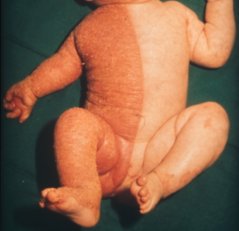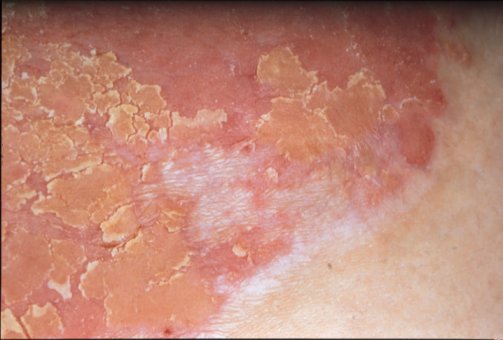CHILD Syndrome

The acronym CHILD stands for “congenital hemidysplasia with ichthyosiform limb defects”. The disease is ultra-rare and inherited as an x-linked dominant trait with lethality for male embryos. This means that the disease is more or less restricted to the female gender. Affected mothers can transmit the disease only to their daughters as male embryos having the gene defect usually die in early pregnancy. As a result affected mothers have only healthy sons who inherited the “healthy” x-chromosome from their mother.
The CHILD Syndrome is characterized by a CHILD nevus that covers a large area mostly in the beginning half of a body site and exhibits a marked demarcation in the middle of the body. The nevus is highly inflammatory, and reminiscent of psoriasis and covered by a wax-like yellow scaling. Usually, the CHILD nevus improves greatly during the first years of life, but has a tendency to persist in the major body folds such as inguinal groins, axilla.
In addition to the CHILD nevus it is possible that on the body site where the nevus is located further deformations can be present. Most of these concern the skeletal system in particular arms or legs, but likewise internal organs, such as kidneys, lung, inner ear or nervous system can be affected. Clinical variability is immense and there are affected women who feature only minimal skin involvement without further associated organ manifestation. Therefore it is important to figure out whether the mother of a severely affected girl is a carrier of the genetic defect.
In the year 2000 members of our NIRK network discovered the underlying genetic defect which can be tested in the blood. It concerns the gene NSDHL on the long arm of the X chromosome. This gene also plays a role in the late steps of cholesterol biosynthesis. Fortunately, the skin lesions respond very well to a topical therapeutic approach considering the pathogenesis of the disease.
The therapeutic approach was conceived in the USA and the topical cream contains 2 per cent of cholesterol as well as 2 per cent of simvastatin, a drug that inhibits biosynthesis of cholesterol and thus results in decrease of cholesterol biosynthesis and toxic cholesterol precursors in the skin. The therapeutic response is awesome, but concerns of course only the skin.

